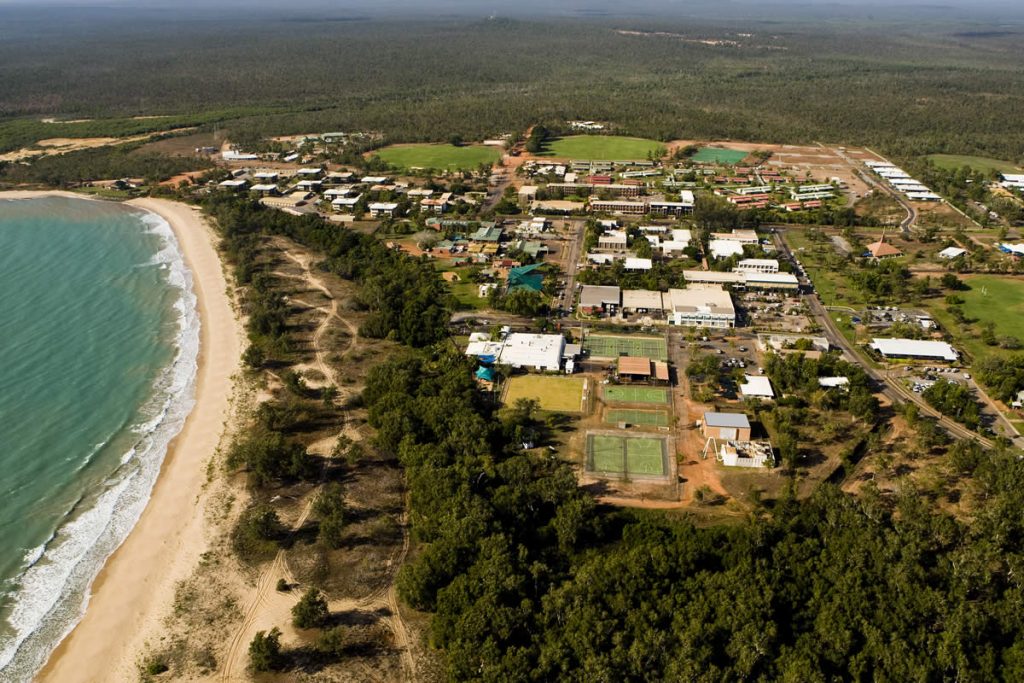
The Northern Territory’s geostrategic importance has never been clearer as longstanding tensions in the Indo-Pacific are exacerbated by the dislocating effects of the Covid-19 pandemic.
The United States has foreshadowed an increased military presence in Darwin, with major planned spending and infrastructure development expected. While Darwin is an ideal location for a forward operating base for Australia and its allies and partners like the US, Japan and others, there’s potential for a larger presence across the Top End in more regional and remote locations.
East Arnhem Land is a pristine natural environment with a rich and extensive history of Aboriginal cultures (Yolngu groups), a significant town (Nhulunbuy—the largest in the region) and a range of communities and homelands. It is also home to the NT’s second deepest naturally occurring port, in the Gulf of Carpentaria approximately 14 kilometres from Nhulunbuy.
Following the Australian government’s enactment of the Aboriginal Land Rights (Northern Territory) Act 1976, the East Arnhem region, which includes the land on which the Gove mine and township sit, was granted to the traditional owners as freehold Aboriginal land. The mining leases are due to expire in 2053, but may be terminated earlier, after which the leases for the mine and township, currently held by the Northern Land Council, will be given over to the Arnhem Land Aboriginal Land Trust. Once that happens, the traditional owners of the Gove Peninsula will be the primary decision-makers for the entire peninsula.
The North Australian Bauxite and Alumina Company (which became Alcan in 2003) originally operated the bauxite mine near Nhulunbuy and expanded its operations there to include an alumina refinery. Alcan was purchased by Rio Tinto, which took control of Nhulunbuy mining operations in 2007. Rio Tinto also provides most of Nhulunbuy’s essential services and is a major financial backer of the school, hospital, power plant (which supplies the refinery and town) and air services.
While mining still occurs on the Gove Peninsula and is expected to continue at the Rio Tinto mine until around 2030, activity at the refinery was curtailed in 2014, resulting in a loss of more than 1,000 jobs and a significant reduction in Nhulunbuy’s population. Following that decision, Indigenous organisations (including Gumatj Corporation, the Rirratjingu Aboriginal Corporation and the Northern Land Council), Rio Tinto, and the NT and Australian governments committed to working towards a positive post-mining future for Nhulunbuy and the Gove Peninsula for Yolngu landowners, local communities, businesses and industry.
Understanding this history of Nhulunbuy and its facilities is essential to considering potential defence and national security uses and appreciating the benefits and potential drawbacks.
Nhulunbuy has several strategic advantages that make it an ideal location for an alliance forward operating base, particularly with some relatively small upgrades and investment.
There are significant power-supply facilities in the area, servicing both the town and the alumina refinery. It was estimated in 2014 that they generate approximately 180 gigawatts annually. Nhulunbuy’s natural deep-water port has infrastructure to service mining and resource companies and it’s one of the primary supply lines into the region. The airstrip is more than 2,200 metres long and 45 metres wide and can accommodate US and Australian military planes, including the giant C-17 Globemaster transport aircraft. While the primary supply line is by sea, the airstrip’s suitability for large aircraft means provides an alternative.
The Nhulunbuy area lies just 12° from the equator, which gives it vast aerospace potential. Equatorial Launch Australia, supported by the Yolngu Gumatj Corporation, the NT government and Developing East Arnhem Limited, are working on the Arnhem Space Centre, approximately 30 kilometres east of Nhulunbuy on the Dhupuma Plateau. The centre will accommodate suborbital and small orbital satellite launch vehicles and provide potential for strategic recognisance operability across the Indo-Pacific.
Health and accommodation facilities in Nhulunbuy have supported the township and Rio Tinto’s operations at their peak and while those operations were winding down. These facilities are located within or close to the township, which is an advantage in that any strategic expansion into Nhulunbuy would likely be integrated into the existing community, avoiding any ‘us and them’ issues prevalent in other communities that host military bases.
While Nhulunbuy presents critical advantages for a forward operating base, challenges remain.
The primary challenge is the mining lease on which the township and alumina refinery sit. Land within a mining lease can be used only for activities stipulated in that lease, which would likely exclude the strategic activities of such a base. While land could be excised, responsibility for any environmental problems created during the term of the mining lease may deter or complicate strategic investment.
Furthermore, many of the overland supply lines into East Arnhem Land would probably need to be significantly upgraded at considerable cost to permit year-round access.
Because the entire East Arnhem region is Aboriginal land, there’d need to be extensive consultation with the traditional owners of the Gove Peninsula and their agreement would be essential. While that may take time and the owners may veto a military presence, establishment of a base also presents an opportunity for significant contributions to the area’s social and economic future.
Allied investment could provide traditional owners with opportunities across training and skills development, employment, and infrastructure upgrades and development, which may otherwise be unattainable.
The long-term nature of such a strategic investment would also address some of the training and development issues that plague projects across remote Australia, which are often piecemeal and bring limited employment opportunities for Aboriginal people. Appropriate engagement and collaboration is key to achieving mutual, sustainable benefits.
For industry, the opportunities generated by a Defence presence would bring significant local economic benefit, assist the development of a skilled workforce and lead to more sustainable economic development for the township.
Because a base in Nhulunbuy could bring broad benefits regardless of these challenges, exploration by the Australian government of what’s needed to establish a sovereign capability on East Arnhem Land fits nicely into the evolving northern Australia strategic defence and national security architecture.

